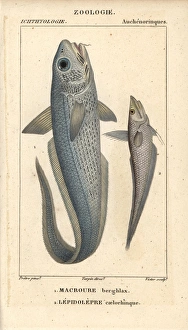Macrourus Collection
Macrourus, also known as grenadiers or rattails, are deep-sea fish with elongated bodies and large eyes
All Professionally Made to Order for Quick Shipping
Macrourus, also known as grenadiers or rattails, are deep-sea fish with elongated bodies and large eyes. These mysterious creatures inhabit the dark depths of the ocean, where they feed on small crustaceans and other marine organisms. Despite their intimidating appearance, they can actually quite harmless to humans. With their long tails and slender bodies, they have adapted to life in the extreme pressures of the deep sea and can be found at depths of up to 6,000 meters, making them one of the most elusive species in the ocean. Their unique physiology allows them to thrive in this harsh environment, where few other creatures can survive. Although macrourus may not be as well-known as some other deep-sea dwellers, they play a crucial role in maintaining the delicate balance of marine ecosystems. As scavengers and predators, they help keep populations of smaller organisms in check and recycle nutrients back into the food chain. Next time you think about the wonders of the ocean, don't forget about these fascinating creatures lurking in its darkest depths. Macrourus may not be flashy or glamorous like some tropical fish, but they are an essential part of our planet's biodiversity and deserve our respect and admiration.










